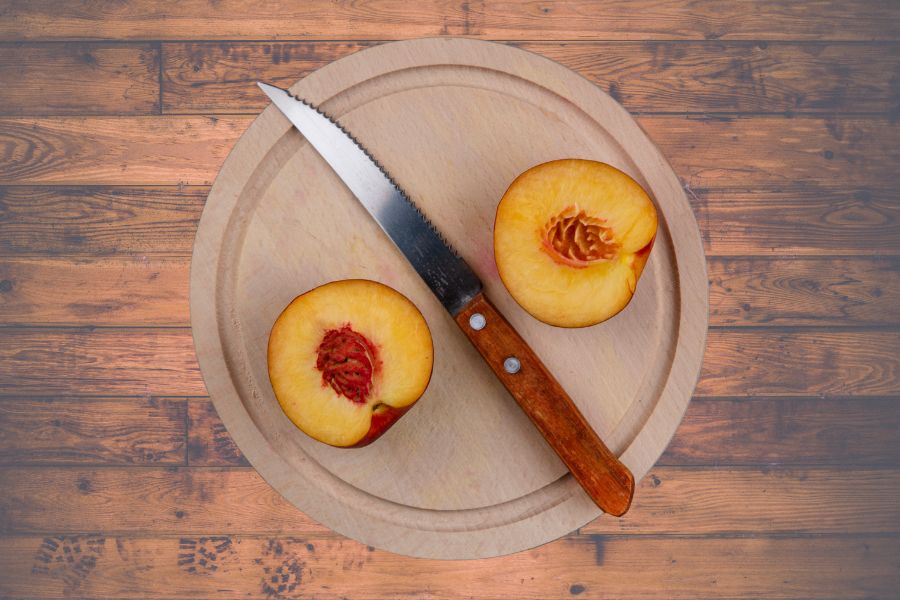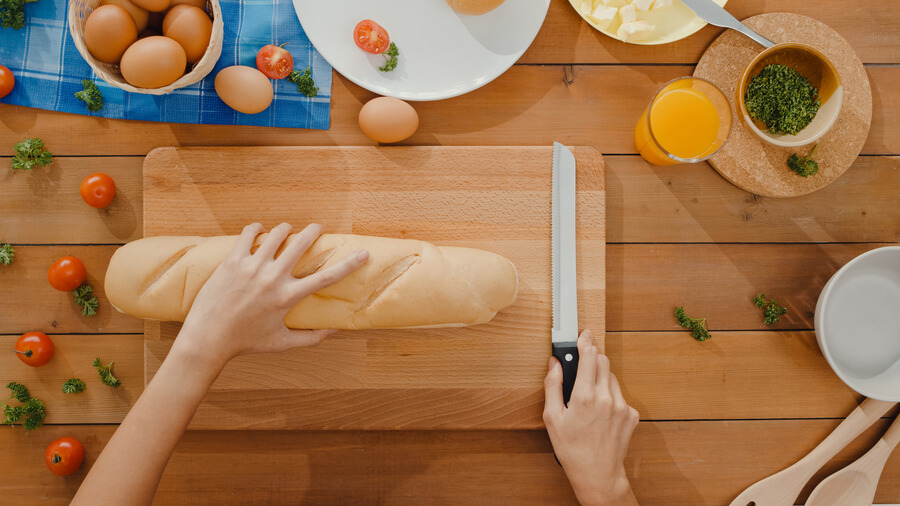You may have a serrated knife in your kitchen without knowing what it is or what to do with it. It is a familiar tool you see in your kitchen drawer occasionally.

The serrated knife might not be the first knife you reach for in your kitchen, but it does serve distinct purposes. It can also be quite helpful in various culinary tasks.
What Exactly Is A Serrated Knife?
A serrated knife is a common type of kitchen knife. You might have heard it called a bread knife or steak knife. Most typical knives come with straight or sometimes slightly curved blades. However, serrated knives are different. Its blade features small, jagged teeth or serrations along its edge. These serrations give the knife a saw-like appearance.
What Are The Possible Uses Of Serrated Knife?
Serrated knives have various uses in the kitchen. They are fancied for their ability to cut through foods with tough or crusty exteriors while preserving the soft interior. Depending on their services, serrated knives come in different sizes. Like the paring knife or chef’s knife, the serrated blade is one of the most indispensable knives in any kitchen.
Here are some common uses of the serrated knife:
For Slicing Bread
The most popular use of serrated knives is to slice bread and other baked goods. Serrated Knives are commonly referred to as bread knives. The serrations can be seen through the crust in clean slices. It does so without crushing the soft interior of the bread. This way, you don’t make a mess while cutting your bread.
Cutting Other Baked Goods
If you love baking, the serrated knife should be an essential piece of equipment in your kitchen. Serrated knives aren’t just handy for slicing bread but also for cutting cakes and various baked goods.
Baked items are soft and delicate, so they need to be missed while minimizing the production of crumbs or compressing the pastry. Many professional bakers use these knives to flawlessly level cake surfaces before applying frosting or other decorative touches.
For Slicing Tomatoes and Other Ingredients
Contrary to the name given to serrated knives, they can be used to cut more than bread and baked goods. Serrated knives are also ideal for slicing tomatoes because the teeth can easily pierce the tough skin. You can still maintain the rigidness of the juicy flesh. With a long serrated knife, you can swiftly slice many cherry tomatoes.
For Chopping Delicate Fruits
They are also helpful in cutting delicate fruits like kiwis, peaches, and plums. This is because the serrations provide a gentle touch and reduce the potential for bruising.
Serrated knives can also be used to neatly section citrus fruits like oranges and grapefruits.

Some serrated knives can be used for zesting citrus fruits like lemons, limes, oranges. They help remove the flavorful outer zest.
Roasts and Meats
Some serrated knives, often called slicing knives, are designed for cutting through significant cuts of cooked meat, such as roasts. The serrations help to create uniform slices.
For Cutting Frozen Foods
Pointed serrated knives work well for cutting through frozen meat since they have a tough exterior. They cut through the ice or frozen food without crushing them. Foods include homemade ice cream sandwiches, key lime pie, or cranberry torte.
Soft Vegetables
This is not an everyday use of the serrated knife, but you can still use it to cut vegetables. Serrated knives can cut soft vegetables like bell peppers or eggplants. You can easily cut them without crushing them.
Hard-Crusted Foods
Suppose you’re looking for a handy knife to slice through foods with hard crusts or tough exteriors. You have serrated knives work. You can use them for your crusty bread, bagels, and cakes.
Cheese
Serrated knives are great for cutting soft or semi-soft cheeses like Brie or Camembert. You can cut them without it sticking or without smooshing them.
Chocolates
Serrated knives can be used to shave or chop chocolate. The serrations reduce the risk of melting the chocolates.
Sandwiches
Serrated knives are often used to cut sandwiches, mainly because they include ingredients like lettuce or tomatoes.
For Peeling Pineapples
A serrated knife’s sharp, jagged teeth can make cutting through pineapple’s tough and prickly skin effortless. A serrated blade can be used to cut off the top and bottom of the pineapple.
You can use the knife to remove the skin by making downward cuts along the sides, following the curvature of the fruit. The serrated edges will grip the tough pineapple skin. Once the skin is removed, the serrated knife can slice the pineapple into rings or chunks.
For Opening a Bottle of Wine
This might sound unconventional, but it still works. It would help if you used a corkscrew to open your bottle. You can use a serrated knife to improvise as a wine bottle opener where you don’t have one.
It is essential to exercise caution while using this method, as there may be better ways to uncork wine. To open the bottle, carefully insert the knife through the cork until it reaches the handle. Then, twist and gently pull. If you can access one, wear cutting gloves for added safety.
How Do You Decide The Right Serrated Knife For Your Use?
As you can see, a Serrated knife is a versatile tool and a must-have for the kitchen. It is one of the most essential kitchen tools you can invest in. If you’re looking for a serrated knife to perform any of the cutting or chopping needs above, you should invest in a high-quality one. So, what should you look for in an excellent serrated knife?
Blade Quality
It would help if you looked for a serrated knife with a high-quality stainless steel blade. These tend to be durable, corrosion-resistant and have a long-lasting sharpness.
The Style of the Serration

Serrated knives have different styles of serrations. It could be scalloped or pointed. Your choice should depend on what your specific cutting needs are. For instance, Scalloped serrations are excellent for soft bread, cakes, or delicate fruits. Otherwise, pointed serrations may be preferable for tough crusts.
Blade Length
Consider the blade length based on your intended use. Longer blades are ideal for slicing large loaves of bread or cakes, while shorter blades work well for smaller tasks.
Handle Comfort
Ensure you’re getting a knife with a comfortable handle. This is crucial if you’ll be using it for an extended time. Look for a serrated knife with an ergonomic handle with a secure grip. Ensure the knife is well-balanced, with the weight evenly distributed between the blade and the handle. This makes it easier to control and reduces hand fatigue.
Price
Serrated knives come in various price ranges. You don’t necessarily need to buy the most expensive one. However, investing in a mid-range or high-quality knife can ensure it serves you well for a long time. Research reputable brands and read up on customer reviews. This can help you gauge the knife’s performance, quality, and durability.
So, the next time you come across a serrated knife in your kitchen drawer, you know how to put it to good use.
